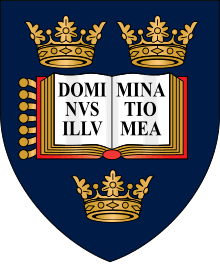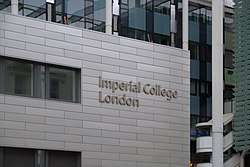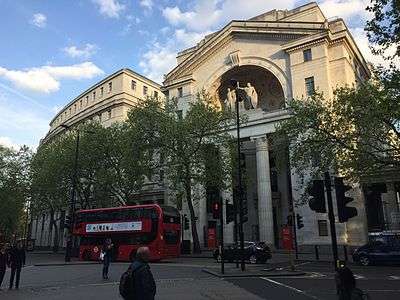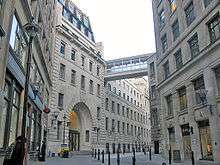Golden triangle (universities)

The "golden triangle" is an unofficial grouping of elite universities located in the English cities of Cambridge, London and Oxford,[7] as listed below:[17]
- University of Cambridge
- Imperial College London
- University of Oxford
- University College London
- King's College London[note 1]
- London School of Economics[note 2]
The corners of the triangle are formed by the University of Cambridge, the University of Oxford and, to the south-east, Imperial College London and University College London. Some sources also include King's College London and the London School of Economics and Political Science.[18] Occasionally other universities in London will also be included, such as the London Business School and the London School of Hygiene and Tropical Medicine.[19]
The institutions typically considered members of the triangle have among the highest research incomes of all British universities and collaborate closely through initiatives such as the G5,[20] Global Medical Cluster (GMEC),[21][22] MedCity,[23] and SES.[24]
Members
Golden triangle universities possess some of the largest UK university financial endowments; endowment sizes range from UCL's £101 million (2016)[25] to Oxford's £5.07 billion (including colleges)[26] Further, each university receives millions of pounds in research fundings and other grants from the UK government, criticised by leaders of some other universities as disproportionate and not in the best interests of the country as a whole.[27] In 2013/14, universities in Oxford, Cambridge and London received 46% of research funding in the UK, up from 42.6% a decade earlier.[28]
| Arms | Institution | Location | Undergraduate enrollment (2016/17)[29] | Graduate enrollment (2016/17)[29] | Total enrollment (2016/17)[29] | 2016 Endowment | Academic staff (2015/16)[30] | Motto | Colours | ||||||||||||||||||||||
|---|---|---|---|---|---|---|---|---|---|---|---|---|---|---|---|---|---|---|---|---|---|---|---|---|---|---|---|---|---|---|---|
 |
University of Cambridge | Cambridge, Cambridgeshire |
12,340 | 7,610 | 19,955 | £3.78 billion (including colleges)[33] | 5,825 | Hinc lucem et pocula sacra (From this place, we gain enlightenment and precious knowledge) |
|||||||||||||||||||||||
 |
Imperial College London | London, Greater London |
9,520 | 8,170 | 17,690 | £126.2 million[35] | 4,770 | Scientia imperii decus et tutamen (Knowledge is the adornment and protection of the Empire) |
|||||||||||||||||||||||
 |
King's College London | London, Greater London |
18,255 | 12,315 | 30,565 | £194.1 million[36] | 4,710 | Sancte et Sapienter (With Holiness and Wisdom) |
|||||||||||||||||||||||
 |
London School of Economics | London, Greater London |
4,810 | 6,395 | 11,210 | £119.2 million[38]:36 | 1,655 | Rerum cognoscere causas (To Know the Causes of Things) |
|||||||||||||||||||||||
 |
University of Oxford | Oxford, Oxfordshire |
14,265 | 10,385 | 24,650 | £5.07 billion (including colleges)[26] | 6,945 | Dominus Illuminatio Mea (The Lord is my Light) |
|||||||||||||||||||||||
 |
University College London | London, Greater London |
18,610 | 19,295 | 37,905 | £101.0 million[43] | 7,220 | Cuncti adsint meritaeque expectent praemia palmae (Let all come who by merit deserve the most reward) |
Rankings
World
Golden triangle universities generally do well on International rankings, which strongly reflect research performance. The LSE has, however, expressed concerns about a bias in rankings against smaller institutions and in favour of universities with large science, technology, engineering and mathematics programmes. Some global rankings, such as those produced by Times Higher Education (THE) and Quacquarelli Symonds (QS), correct for the sizes of institutions in calculating their results but others, such as the Academic Ranking of World Universities (ARWU), make no such adjustment.[44][45]
| University | THE World (2017/18)[46] | QS World (2017/18)[47][48] | US News Global (2017/2018)[49][50] | THE Global Employability (2017/2018)[51][52] | Academic Ranking of World Universities (2017/2018)[53] |
|---|---|---|---|---|---|
| University of Cambridge | 2 | 5 | 7 | 5 | 3 |
| Imperial College London | 8 | 8 | 17 | 17 | 27 |
| King's College London | 36 | 23 | 41 | 25 | 46 |
| London School of Economics[note 3] | 25 | 35 | 244 | 46 | 151-200 |
| University of Oxford | 1 | 6 | 5 | 15 | 7 |
| University College London | 16 | 7 | 22 | 49 | 16 |
National
The Golden Triangle universities generally do well on British university league tables, with Cambridge and Oxford consistently first and second, and Imperial and UCL ranked in the top ten by all compilers. The LSE, however, misses out on a top ten place in the Guardian University Guide, while King's College London fails to make the top ten except in the Times Higher Education employability survey of UK recruiters.
In The Sunday Times' 10-year (1998–2007) average ranking of British universities based on consistent league table performance; Cambridge, Oxford, LSE, Imperial and UCL (in order) claimed the top 5 positions whilst King's was placed joint 14th.[54] With the exception of King's, the remaining members of the Golden Triangle have never left the top 15 in one of the three main domestic rankings between 2008 and 2017.[55]
| University | THE Table of Tables (2017)[56] | Complete (2018)[57] | THE UK Employability (2018)[51] | Guardian (2018)[58] | The Times (2017)[59] |
|---|---|---|---|---|---|
| University of Cambridge | 1 | 1 | 1 | 1 | 1 |
| Imperial College London | 4= | 5 | 3 | 6= | 5 |
| King's College London | 25 | 21 | 4 | 39 | 29 |
| London School of Economics | 7 | 4 | 6 | 15 | 8 |
| University of Oxford | 2 | 2 | 2 | 2 | 2 |
| University College London | 11 | 7 | 7 | 10= | 6 |
Research income
| Rank[60] | University | Research income (£m) | Research income as proportion of income (%) |
| 1 | University of Oxford | 534.3[61] | 42.6 |
| 2 | University College London | 529.5[62] | 40.0 |
| 3 | University of Cambridge | 462.4[63] | 28.1 |
| 4 | Imperial College London | 348.2[64] | 36.8 |
| 7 | King's College London | 193.2[65] | 26.2 |
| 43 | London School of Economics | 30.3[38]:30 | 9.2 |
Graduate earning power
Research in 2017 by the Institute for Fiscal Studies also indicates graduates from the LSE, Oxford and Imperial earn, on average, over £40,000 per year 5 years after graduation, making them the highest earners 5 years after graduation amongst British university graduates.[66] Furthermore, the rest of the golden triangle member institutions, along with St George's (University of London), make up the top 7 table of the highest earners. [67]
Gallery


.jpg)
.jpg)
See also
- Research-intensive cluster
- G5
- Global Medical Excellence Cluster
- Imperial Universities (Japan)
- MedCity (London)
- SES-5 A formal grouping of universities in the South East of the UK
- Ivy League (older private universities in the United States)
- Russell Group A formal grouping of research universities in the UK
- SKY (universities) (Korea)
- C9 League The Chinese Ministry of Education's formal grouping of elite universities in China
Notes
- ↑ King's College London is not included by all sources[9][10][13][14][16]
- ↑ LSE is not included by all sources[8][13][14][16]
- ↑ The LSE made the following statement about university rankings in 2012: "At mid-2012, LSE has seen pleasing improvements over the last couple of years in our standing in all the main global rankings: those produced by Times Higher Education, QS and Shanghai Jiaotong University. We have also seen good rises in the domestic UK rankings. But we remain concerned that all of the global rankings – by some way the most important for us, given our highly international orientation – suffer from inbuilt biases in favour of large multi-faculty universities with full STEM (Science, Technology, Engineering and Mathematics) offerings, and against small, specialist, mainly non-STEM universities such as LSE."[44]
References
- ↑ "Oxbridge windfall". Times Higher Education. 4 August 1995.
A large amount of the cash awarded to humanities postgraduates still goes to the "Golden Triangle" of Oxford, Cambridge and London, British Academy figures reveal.
- ↑ Kershaw, Alison (4 October 2012). "UK universities slip in rankings". The Independent.
Rankings editor Phil Baty said: "Outside the golden triangle of London, Oxford and Cambridge, England's world-class universities face a collapse into global mediocrity.
- ↑ Andrew Ward (25 June 2015). "Johnson floats £10bn biotech fund for London". Financial Times.
MedCity was launched last year to increase collaboration between Imperial College, King's College and University College London – the capital's three main science universities – and promote the broader 'golden triangle' between London, Cambridge and Oxford to investors.
- ↑ Rebecca Marriage (11 March 2015). "UK confirmed as 'global education superpower' in international university rankings". ReLocate Global.
The 'golden triangle' of Oxford, Cambridge and London strengthened its grip on UK higher education: As well as Cambridge and Oxford rising closer to the summit, University College London moved up from 25th to 17th, the London School of Economics rose two places to 22nd and King's College London jumped eight places from 43rd to 31st.
- ↑ Mullins, Justin (23 April 2005). "England's golden triangle". New Scientist.
Take a look at any of the various league tables ranking universities around the world ... Oxford and Cambridge are in the top handful, while London's University College and Imperial College sit comfortably in the top 25. ... London, Oxford and Cambridge are a 'golden triangle' of academic success.
- ↑ Wiggins, Kaye (11 March 2015). "The World Reputation Rankings: UK's university 'golden triangle' strengthens grip".
The "golden triangle" of Oxford, Cambridge and London has strengthened its grip on the UK's higher education system, according to the latest global reputation rankings from TES's sister title Times Higher Education.
- ↑ Multiple sources state the golden triangle is formed around Oxford, Cambridge and London[1][2][3][4][5][6]
- 1 2 "Golden opportunities". Nature. 6 July 2005.
No longer rivals, Oxford, Cambridge and London are now working towards a common goal – ensuring the 'golden triangle' becomes a global science hub.
(Names Oxford, Cambridge, UCL, King's and Imperial) - 1 2 Zoe Corbyn (26 November 2009). "In research, small is just as beautiful". Times Higher Education.
The findings reveal the full extent of the dominance of the golden triangle: papers from the universities of Oxford, Cambridge, University College London, Imperial College London, and the London School of Economics were cited far more often than the world average
(Names Oxford, Cambridge, UCL, Imperial and LSE) - 1 2 "'Golden triangle' to win funding riches". Times Higher Education. 11 February 2010.
The other institutions in the Cambridge-Oxford-London 'golden triangle' – University College London, Imperial College London and the London School of Economics – will also receive big cash windfalls, as will the University of Manchester.
(names Oxford, Cambridge, UCL, Imperial and LSE) - ↑ Sean Coughlan (3 October 2013). "London top city in global university rankings". BBC News.
The so-called 'golden triangle' of UK universities – Oxford, Cambridge and leading London institutions – is seen as a breakaway elite group, with these universities consolidating their international reputations. Imperial College, University College London, LSE and King's College London are all in the top 40.
(Names Oxford, Cambridge, UCL, King's, Imperial and LSE) - ↑ Miriam Frankel; Alison Goddard; Gretchen Ransow (18 December 2014). "Golden Triangle pulls ahead in REF shake-out: UCL and KCL ascend power rankings, Manchester and Leeds fall" (PDF). Research Fortnight.
The top six universities in the so-called golden triangle—Oxford, UCL, Cambridge, Imperial, KCL and the London School of Economics and Political Science—have done particularly well in the Power Ratings.
(Names Oxford, Cambridge, UCL, King's, Imperial and LSE) - 1 2 3 Jha, Alok (3 June 2003). "Gold rush". The Guardian.
The golden triangle of Oxford, Cambridge, University College London and Imperial College, show no sign of slowing down in their race away from the rest of the sector when it comes to research funding.
(Names Oxford, Cambridge, UCL and Imperial) - 1 2 3 OECD Reviews of Regional Innovation OECD Reviews of Regional Innovation, North of England, UK. OECD. 2008. p. 222.
The "Golden Triangle" of ... the universities of Oxford and Cambridge, Imperial College and University College of London ...
(Names Oxford, Cambridge, UCL and Imperial) - ↑ Grant, Malcolm (1 March 2005). "The future of the University of London: a discussion paper from the Provost of UCL" (PDF): 6. (Names Oxford, Cambridge, UCL, King's, Imperial and LSE)
- 1 2 3 Clark, Paul (1 March 2002). "The golden triangle holds the secret". Times Higher Education.
Suppose, for the sake of argument, that the four institutions comprising the 'golden triangle' – Cambridge, Imperial College, Oxford and University College London – elect not to receive their block Higher Education Funding Council for England grant for teaching.
(Names Oxford, Cambridge, UCL and Imperial) - ↑ Multiple sources confirm the membership, although some omit either King's or LSE, as noted under their entries[8][9][10][11][12][13][14][15][16]
- ↑ Mike Savage (5 November 2015). Social Class in the 21st Century. Penguin. p. 167.
Higher education researchers often talk about a 'Golden Triangle' of universities. The 'triangle' describes an imaginary three-sided shape with corners in Oxford, Cambridge and London. The exact composition of the London 'corner' can vary, but typically it includes the London School of Economics, King's College London, University College London and Imperial College London.
- ↑ "World Reputation Rankings 2014 results: UK's 'golden triangle' accounts for 8 of the country's 10 representatives in top 100". Times Higher Education. Retrieved 14 June 2017.
- ↑ "Super elite in secret bid for cash boost". Times Higher Education. 6 February 2004. Retrieved 30 March 2014.
- ↑ "Universities". GMEC. Archived from the original on 6 March 2014. Retrieved 4 August 2016.
- ↑ "Collaborate and listen, The Guardian, Tuesday 19 December 2006"
- ↑ "MedCity launched to promote South East's science 'golden triangle'". BBC News. 8 April 2014. Retrieved 8 April 2014.
- ↑ "Research heavyweights deny 'ganging up'". Times Higher Education. 9 May 2013. Retrieved 30 March 2014.
- ↑ "Annual Report and Financial Statements for the year ended 31 July 2016" (PDF). UCL. Retrieved 23 May 2017.
- 1 2 Colleges £4,159.1M,[40] University (consolidated) £909.8M[41]
- ↑ Rebecca Attwood (16 February 2007). "South secures research cash". Times Higher Education.
- ↑ "Golden triangle increases share of research funding".
- 1 2 3 "2016/17 Students by HE provider, level, mode and domicile" (CSV). Higher Education Statistics Agency. Retrieved 25 March 2018.
- ↑ "Staff in Higher Education 2015/16". HESA. Retrieved 26 May 2017.
- ↑ "Accounts of the Colleges". Cambridge University Reporter. University of Cambridge. 18 January 2017. Retrieved 26 May 2017.
- ↑ "Statement of changes in reserves for the year ended 31 July 2016". Cambridge University Reporter. University of Cambridge. 8 December 2016. Retrieved 26 May 2017.
- ↑ Colleges £2,263.6M,[31] University (consolidated) £1,519M[32]
- ↑ "Identity Guidelines – Colour" (PDF). University of Cambridge Office of External Affairs and Communications. Retrieved 15 July 2016.
- ↑ "Annual Report and Accounts 2015–16" (PDF). Imperial College London.
- ↑ "Financial Statements for the year to 31 July 2016" (PDF). King's College London. Retrieved 10 February 2017.
- ↑ "Branding Essentials". Branding Essentials 10 August 2015. Archived from the original on 12 November 2015. Retrieved 15 July 2016.
- 1 2 "Financial Statements for the Year to 31 July 2016" (PDF). London School of Economics. Retrieved 4 January 2017.
- ↑ "LSE Shop". Shop.edirectory.co.uk. Archived from the original on 31 January 2009. Retrieved 15 July 2016.
- ↑ Oxford University Colleges Financial Statements 2016
- ↑ "Financial Statements 2015/16" (PDF). University of Oxford. Retrieved 10 March 2017.
- ↑ "The brand colour – Oxford blue". University of Oxford. Retrieved 16 August 2013.
- ↑ "Annual Report and Financial Statements for the year ended 31 July 2016" (PDF). UCL. Retrieved 11 January 2017.
- 1 2 "LSE in university league tables". London School of Economics. Archived from the original on 4 March 2016.
- ↑ Bahram Bekhradnia (15 December 2016). "International university rankings: For good or ill?" (PDF). Higher Education Policy Institute. Retrieved 26 May 2017.
- ↑ "World University Rankings". Times Higher Education (THE). 18 August 2017. Retrieved 3 January 2018.
- ↑ "QS World University Rankings 2018". Top Universities. 5 June 2017. Retrieved 3 January 2018.
- ↑ "QS World University Rankings 2016/17". Quacquarelli Symonds Ltd. Retrieved 6 September 2016.
- ↑ "Best Global Universities Rankings, US News". US News. September 2017. Archived from the original on 2014-10-28.
- ↑ "Best Global Universities Rankings". US News and World Report. Retrieved 24 May 2017.
- 1 2 "Graduate employability: top universities in the UK ranked by employers". Times Higher Education (THE). 16 November 2017. Retrieved 3 January 2018.
- ↑ "Best universities for graduate jobs: Global University Employability Ranking 2016". Times Higher Education. 16 November 2016.
- ↑ http://www.shanghairanking.com/ARWU2017.html
- ↑ "University ranking based on performance over 10 years" (PDF). The Times. London. 2007. Archived from the original (PDF) on 14 April 2008. Retrieved 28 April 2008.
- ↑ "Domestic Ranking of British Universisities over a 10-Year Period". The University Buzz.
- ↑ Chris Havergal (12 October 2016). "THE 'Table of Tables' 2017: Loughborough catching up with elite". Times Higher Education.
- ↑ "University League Tables 2018". Complete University Guide. Retrieved 23 May 2017.
- ↑ "University league tables 2018". The Guardian. 16 May 2017.
- ↑ "The Times and Sunday Times University Good University Guide 2017". Retrieved 23 September 2016. (subscription required)
- ↑ "University financial health check 2016" (PDF). Times Higher Education. 2 June 2016. Retrieved 23 May 2017.
- ↑ "Financial Statements 2015/16" (PDF). University of Oxford. Retrieved 10 March 2017.
- ↑ "Annual Report and Financial Statements for the year ended 31 July 2016" (PDF). University College London. Retrieved 11 January 2017.
- ↑ "Reports and Financial Statements for the year ended 31 July 2016" (PDF). University of Cambridge. Retrieved 8 January 2017.
- ↑ "Annual Report and Accounts 2015–16" (PDF). Imperial College London. Retrieved 21 December 2016.
- ↑ "Financial Statements for the year to 31 July 2016" (PDF). King's College London. Retrieved 10 February 2017.
- ↑ https://www.bbc.co.uk/news/education-41693230
- ↑ http://www.dailymail.co.uk/money/news/article-5093461/The-universities-earn-graduates-highest-salaries.html

